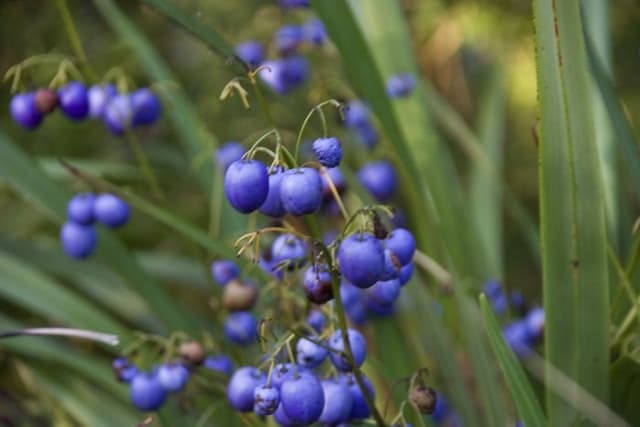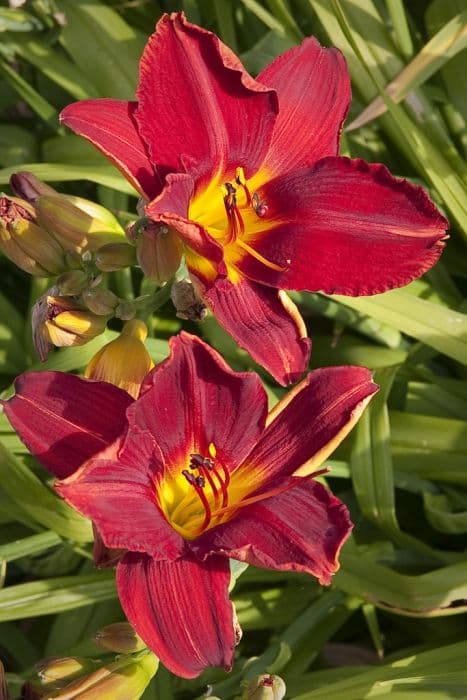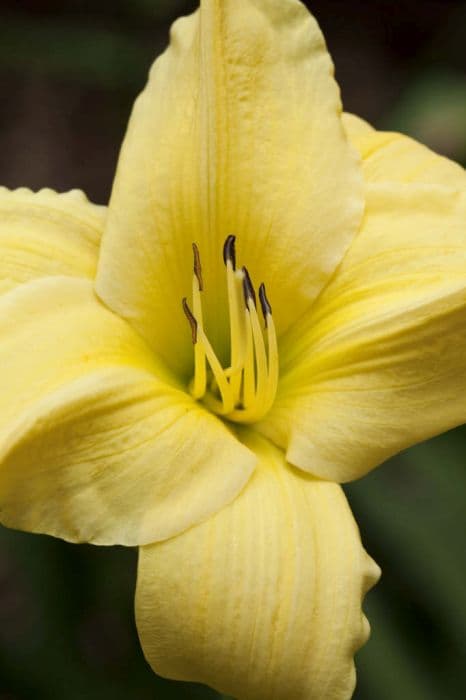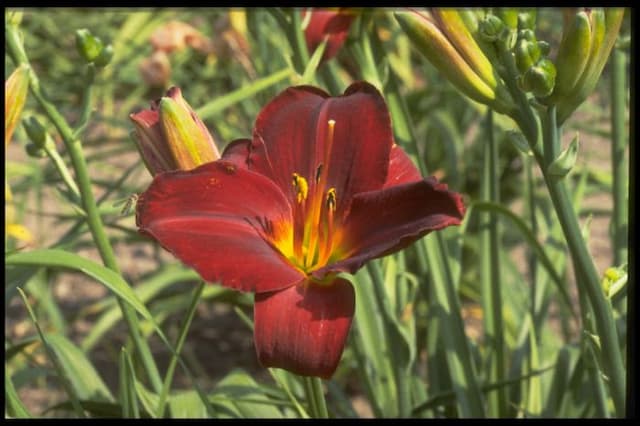Daylily Hemerocallis 'Destined to See'

ABOUT
Hemerocallis 'Destined to See' is commonly known as a daylily. This plant boasts a delightful and showy floral display. The flowers are characterized by their unique coloration—usually a delicate blend that may feature a creamy base, adorned with a distinct eye-catching ring or pattern in a contrasting hue such as purple or maroon. The petals are often ruffled and have smooth, slightly recurved edges that give them a graceful and elegant appearance. The blooms have a trumpet-like form that flares open at the tips to reveal a yellow or greenish throat, adding to their allure. The plant itself has long, slender leaves that emerge from the base in a dense clump, creating an attractive, arching fountain of greenery. These leaves are strap-like and have a somewhat grass-like appearance, which allows the plant to add textural interest to the garden even when it's not in bloom. The daylily 'Destined to See' produces multiple flower scapes, each bearing several buds that open successively over a period of time, ensuring a prolonged display of its stunning blossoms. It is a perennial and is known for both its beauty and resilience in a variety of garden conditions.
About this plant
 Names
NamesSynonyms
Daylily
Common names
Hemerocallis 'Destined to See'.
 Toxicity
ToxicityTo humans
The daylily, which 'Destined to See' is a variety of, is generally not considered toxic to humans. In fact, some parts of the plant are edible and are used in culinary practices in certain cultures. However, like with any plant, individual sensitivity can vary, and someone might experience a reaction if they have a specific allergy. There is no widespread documented toxicity from eating daylilies for the general population.
To pets
The daylily is considered toxic to cats. Ingesting this plant can cause symptoms such as vomiting, lethargy, kidney failure, or even death in severe cases. Dogs are typically not affected by daylilies in the same way, but it's always best to keep all pets from ingesting plants not intended for them to avoid the potential for individual reactions or digestive upset.
 Characteristics
CharacteristicsLife cycle
Perennials
Foliage type
Deciduous
Color of leaves
Green
Flower color
Mixed
Height
2 feet 24 inches (60 cm)
Spread
2 feet 24 inches (60 cm)
Plant type
Herb
Hardiness zones
3-9
Native area
Asia
Benefits
 General Benefits
General Benefits- Aesthetic Appeal: The Hemerocallis 'Destined to See', commonly known as daylily, has vibrant and colorful blooms that enhance the visual appeal of any garden or landscape.
- Low Maintenance: Daylilies are known for their hardiness and require minimal care once established, making them ideal for gardeners of all skill levels.
- Drought Tolerance: They are quite tolerant of drought conditions and can thrive with minimal watering, making them suitable for dry climates.
- Pest Resistance: Daylilies tend to be resistant to many pests and diseases, reducing the need for chemical treatments.
- Soil Adaptability: They can grow in a wide range of soil types, from sandy to clay, as long as the soil is well-drained.
- Propagation Ease: Daylilies can be easily propagated through division, allowing gardeners to increase their stock and share with others.
- Long Blooming Period: They often have a lengthy blooming season, providing color and interest in the garden for an extended period.
- Wildlife Attraction: The flowers can attract pollinators such as birds, bees, and butterflies, contributing to a healthy ecosystem.
 Medical Properties
Medical PropertiesThis plant is not used for medical purposes.
 Air-purifying Qualities
Air-purifying QualitiesThis plant is not specifically known for air purifying qualities.
 Other Uses
Other Uses- Edible Flowers: The blooms of the daylily 'Destined to See' can be eaten raw in salads, offering a mild, sweet flavor and a crunchy texture.
- Natural Fabric Dye: The petals can be used to produce a natural dye for fabrics, imparting a soft yellow or orange hue.
- Compost Material: Once spent, daylily flowers and leaves enrich compost piles by adding vital nutrients as they decompose.
- Photography Subject: With their striking appearance, these daylilies are often used by photographers to practice macro and nature photography.
- Garden Bordering: The dense foliage and clumping growth habit make 'Destined to See' an effective plant for defining the edges of garden paths and flower beds.
- Wildlife Attraction: Daylilies can attract beneficial pollinators like bees and butterflies to a garden, helping to pollinate other plants.
- Water Garden Accent: Although not an aquatic plant, 'Destined to See' daylilies can be planted around water features to add color and beauty.
- Culinary Garnish: The vibrant flowers can serve as an edible garnish for desserts and culinary presentations.
- Craft Projects: Dried daylily blooms can be utilized in craft projects, such as making natural potpourri or decorative arrangements.
- Mood Enhancing Decor: The vivid colors and pleasant form of daylilies can be used in floral arrangements to enhance the aesthetics and mood of interiors.
Interesting Facts
 Feng Shui
Feng ShuiThe Daylily is not used in Feng Shui practice.
 Zodiac Sign Compitability
Zodiac Sign CompitabilityThe Daylily is not used in astrology practice.
 Plant Symbolism
Plant Symbolism- Longevity and Survival: Hemerocallis, commonly known as daylily, symbolizes longevity due to its robust nature and ability to thrive in various conditions. The name 'Destined to See' implies endurance and a future filled with experiences.
- Beauty and Transience: Known for their beautiful flowers that typically last just a day, daylilies remind us of the transient nature of beauty and life, reminding us to appreciate every moment.
- Motherhood: In Chinese culture, daylilies are associated with motherhood due to their nature of producing numerous offspring or blooms, symbolizing fertility and abundance.
- Renewal and Hope: The 'Destined to See' variety, with its recurrent blooming, can also be seen as a symbol of renewal and hope, suggesting that each day brings new opportunities and possibilities.
- Forgiveness: The gentle appearance and the daily renewal of flowers can represent forgiveness, indicating that each day is a new beginning and a chance to let go of past grudges.
 Water
WaterThe daylily, commonly known as Hemerocallis 'Destined to See', requires moderate watering. It is best to water the plant once a week with about 1 inch of water, ensuring the soil is moist but not waterlogged. During periods of extreme heat or drought, you may need to increase watering to twice a week. Always water at the base of the plant to avoid wetting the foliage, which can lead to fungal diseases. It is necessary to reduce watering during the dormant winter months to prevent root rot.
 Light
LightDaylilies, including Hemerocallis 'Destined to See', thrive best in full sunlight to partial shade. Ideally, they should receive at least six hours of direct sunlight per day. A spot with morning sunlight and afternoon shade or dappled sunlight throughout the day is optimal for promoting vibrant blooms and healthy growth.
 Temperature
TemperatureDaylilies, such as Hemerocallis 'Destined to See', prefer moderate temperatures and can tolerate a range of weather conditions. They are cold-hardy and can survive winter temperatures down to about -20°F, while in the growing season, they flourish in temperatures ranging from 60°F to 90°F. The ideal temperature for vigorous growth and bloom production is between 70°F and 85°F.
 Pruning
PruningPruning of daylilies, including Hemerocallis 'Destined to See', primarily involves removing spent flower stems and dead foliage to maintain plant health and appearance. Deadheading, the process of removing faded flowers, should be done regularly during the blooming season to promote more blooms. After the plant has finished flowering for the season, cut back the foliage if it looks ragged or brown. The best time for a thorough clean-up pruning is late fall or early spring.
 Cleaning
CleaningAs needed
 Soil
SoilThe best soil mix for Daylilies (Hemerocallis 'Destined to See') should be well-draining and rich in organic matter. A combination of garden soil, compost, and a little sand or perlite works well. Daylilies prefer slightly acidic to neutral soil, with an optimal pH range of 6.0 to 7.0.
 Repotting
RepottingDaylilies typically do not need frequent repotting and can thrive when left undisturbed for several years. However, if growth is poor or the plant has outgrown its space, repotting can be done every 3 to 4 years.
 Humidity & Misting
Humidity & MistingDaylilies are not particularly sensitive to humidity levels and can handle a wide range. They do well in the average outdoor humidity conditions they are typically exposed to, without the need for special adjustments.
 Suitable locations
Suitable locationsIndoor
Place Daylilies in bright, indirect light indoors.
Outdoor
Plant in full sun to partial shade, in well-draining soil.
Hardiness zone
3-9 USDA
 Life cycle
Life cycleHemerocallis 'Destined to See', commonly known as the Daylily, starts its life as a seed which germinates in moist soil conditions, typically in spring or early summer. Upon sprouting, the seedling grows roots and shoots, developing into a young plant with strappy leaves. Over the course of several weeks to months, the daylily matures, forming clumps through the expansion of its root system and the emergence of new shoots. Once mature, the plant produces flower stalks called scapes, which bear the distinctive, trumpet-shaped flowers, often blooming for just one day. After pollination, these flowers can produce seed pods that, if conditions permit, will mature and eventually disperse seeds, continuing the cycle. During winter or adverse conditions, the daylily enters a dormant period, where the above-ground foliage may die back, but the roots remain alive, ready to regrow when conditions become favorable.
 Propogation
PropogationPropogation time
Late summer to fall
The Hemerocallis 'Destined to See', commonly known as a Daylily, is best propagated through division. This process is typically done in the late summer to early fall after the flowering period has ceased. To propagate by division, first, carefully dig around the clump of the Daylily, trying not to damage the roots. Gently lift the clump from the ground and shake off any excess soil. Using a sharp knife or spade, divide the clump into smaller sections, ensuring that each section has at least one or two fans of leaves and a portion of the root system. Replant the divisions at the same depth they were growing at previously, spacing them about 18 to 24 inches apart (45 to 60 centimeters), and water them thoroughly to help establish the new plants. This method allows the plant to recover and establish itself before the onset of winter, providing a head start for growth in the spring.









